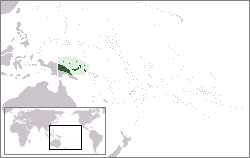Territory of New Guinea
| Territory of New Guinea | ||||||||||
|
League of Nations Mandate of Australia (1920–1946) United Nations Trust Territory of Australia (1946–1975) |
||||||||||
|
||||||||||
|
||||||||||
|
Location of the Territory of New Guinea in western Oceania.
|
||||||||||
| Capital | Rabaul | |||||||||
| Languages |
English (official) Austronesian languages Papuan languages English creoles German creoles |
|||||||||
| Government | Mandate, later Trust Territory of Australia | |||||||||
| King | List of British monarchs | |||||||||
| Administrator | List of colonial heads of New Guinea | |||||||||
| Prime Minister | List of Prime Ministers of Australia | |||||||||
| Historical era | Interwar period | |||||||||
| • | Treaty of Versailles | 28 June 1919 | ||||||||
| • | Union with Papua | 1975 | ||||||||
| Currency | Australian pound | |||||||||
|
||||||||||
The Territory of New Guinea was an Australian administered territory on the island of New Guinea from 1920 until 1975. In 1949, the Territory and the Territory of Papua were established in an administrative union by the name of the Territory of Papua and New Guinea. That administrative union was renamed as Papua New Guinea in 1971. Notwithstanding that it was part of an administrative union, the Territory of New Guinea at all times retained a distinct legal status and identity until the advent of the Independent State of Papua New Guinea.
The initial Australian mandate was based on the previous German New Guinea, which had been captured and occupied by Australian forces during World War I.
Most of the Territory of New Guinea was occupied by Japan during World War II, between 1942 and 1945. During this time, Rabaul, on the island of New Britain, became a major Japanese base (see New Guinea campaign). After World War II, the territories of Papua and New Guinea were combined in an administrative union under the Papua New Guinea Provisional Administration Act (1945–46).
Archeological evidence suggests that humans arrived on New Guinea at least 60,000 years ago. These Melanesian people developed stone tools and agriculture. Portuguese and Spanish navigators sailing in the South Pacific entered New Guinea waters in the early part of the 16th century and in 1526–27, Don Jorge de Meneses came upon the principal island "Papua". In 1545, the Spaniard Iñigo Ortiz de Retes gave the island the name "New Guinea" because of what he saw as a resemblance between the islands' inhabitants and those found on the African Guinea coast. Knowledge of the interior of the island remained scant for several centuries after these initial European encounters. In 1884, Germany formally took possession of the northeast quarter of the island and it became known as German New Guinea.
...
Wikipedia



